
A 501(c)3 Non-Profit Education Organization - 25 May 2017
Measuring the Energy of Light
Editor's Note: Thanks to an outpouring of support from many of you, the ISG newsletter will be able to continue. From Chatham Created Gem's donation of $500.00 to a list of donations from $20.00 to $200.00, we will be able to continue this newsletter for the present time. Thank you to all of you for supporting your International School of Gemology. Rj
____________________________________________________________________________
Last week we looked at why light sources are important when viewing gemstones. A full spectrum light gives a gemstone a complete set of energy levels to use in order to produce one or more colors that we see. Use a light with a limited spectrum, such as a fluorescent desk light, and you don't give the gemstone a full set of "tools" to work with to produce colors. As we saw with the spectra of difference gemstones, each produces its own specific color based on selectively absorbing certain colors while passing the rest through to our eyes where we perceive the colors.
We can carry this demonstration one step further and actually measure one type of energy of light using a simple prism, a baby thermometer and some time in the back yard of our ISG office. While the physics of this is far above my pay grade, as usual I try to find simple ways to demonstrate otherwise technical issues so that those of us without PhD's in physics can understand the concept.
The Concept: Since each color of the spectrum represents a slightly different energy level, each color should produce a slightly different energy reaction when tested. In our case, we are going to test thermal energy. This will only deal with the heat produced by the spectrum of colors and nothing else. So please don't any physics PhD guys contact me about some high tech physics of electron volts and all of that. I realize it takes, for instance, 2.5eV for chromium to produce a red color in ruby (thank you Gem-A) but for our purposes we are going to keep it simple and measure the heat differences of spectrum colors.
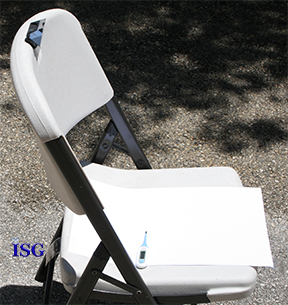
The Set Up: In order to compare the variable thermal energy, or heat, of the spectrum, we must first create a spectrum of light strong enough to be measurable thermal energy.
For this purpose I used a chair, a prism, a baby thermometer and paper. Since the strongest spectrum I could create is the spectrum of the sun, I went outside and worked for a half hour to orient this set up just right to produce the spectrum of the sun on a paper, using the small prism as you see at left on the top of the back of this chair.
But there were problems that had to be resolved before this would work...
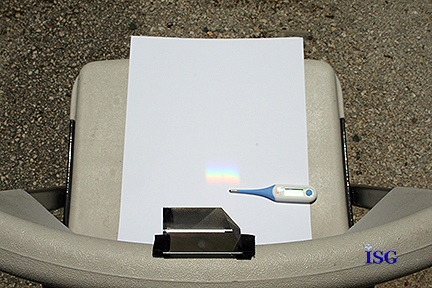
While the spectrum is fairly easy to create, the problem is measuring the thermal temperature in direct sunlight negates the ability to measure the temperature of the individual colors. The ambient temperature in the shade on this day was a confirmed 87 degree F. But in direct sunlight, the thermometer measured 109.9F as seen below. So the trick was to have the prism in the direct sunlight to produce a complete and full spectrum, and yet have the spectrum projected in the shade where the ambient temperature would be equal and allow measurement of each color of the spectrum.

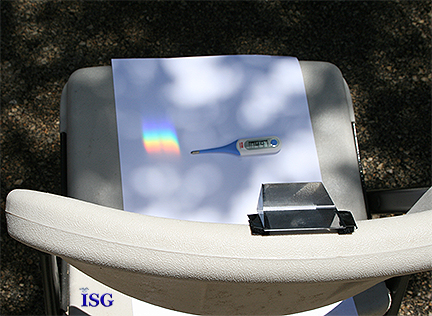
This required a bit of moving and testing to get the seat of the chair under the shade of a Texas Live Oak tree, while keeping the back of the chair with the prism in the direct sunlight. By carefully placing the set up as you see at left, I was able to measure the temperature or thermal energy of each end of the visible spectrum in the controlled ambient temperature of the shade.
Below are the results that demonstrate how different colors in the visible light spectrum will offer variable temperatures, and how that allows us to measure at least one very basic energy level of light.
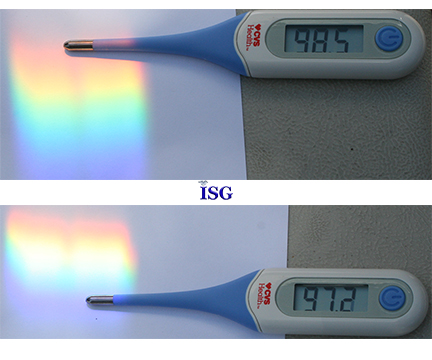
Here you see the temperature readings from the far red side of the spectrum to the indigo or blue side. We know the ambient temperature in the shade at this time was 87 degrees F. The blue end measures 97.2 F while the red end measures 98.5F, or a difference of 1.3 degrees F in this spectrum of colors from the sun, taken at the same place and same time of day, just moving the thermometer from one side to the other.
We know the direct sunlight was 109.9 F, and the ambient temperature in the shade was 87F, so the difference in this thermometer reading between these two colors demonstrates the difference in thermal or heat energy of these two color regions within this spectrum.
OK, one more.
Just to make sure this demonstration was predictable and repeatable, I waited until later in the day and performed the same measurement. The results are below. The ambient temperature in the shade had fallen to around 80 degrees F. Below are the new readings in the later afternoon sunlight.
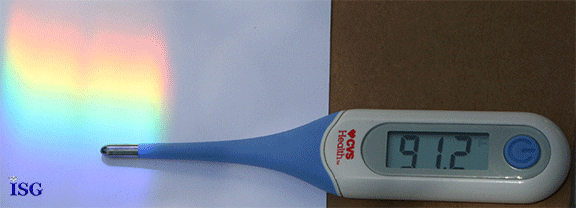
As you can see, 91.2F in the blue end, and 92.9F in the red. A difference of 1.7 degrees F between these two sides of the spectrum.
The concept that the red colors generate more heat is no magical, mystery information. Anyone who has lived or traveled to the Caribbean and seen so many of the houses with red tile roofs understand that reflecting the red color of the spectrum is also reflecting heat off the roof of the house. But that is a side issue to the whole thing, but one that I thought I would throw in.
Bottom line is that elements inside a gemstone utilize the variable energy levels of light to produce the amazing colors we see. Chromium uses light to produce red in rubies, green in emeralds, and red and green in alexandrites. The list could go on and on. Gemstones need a complete spectrum of light to produce the most amazing colors. In this demonstration we have seen just a tiny part of this amazing story. By measuring the energy of light in this small way, we can better understand how light and gemstones interact to produce beautiful colors in nature's most wondrous gifts....colored gemstones.
Please help us by sharing this newsletter with your friends:
Robert James FGA, GG
President, International School of Gemology
If you enjoyed reading this newsletter, please consider donating to help us keep it going. All donations to the ISG are tax deductible under IRS 501(c)3. We appreciate your supporting our efforts to keep this a free educational newsletter for all who love gemstones. There is so much more to learn, demonstrate and show you.
To learn more about the education programs and opportunities at the International School of Gemology, please visit http://www.schoolofgemology.com .
©2017 International School of Gemology Inc. ALL RIGHTS RESERVED. We encourage sharing and caring throughout the industry as long as all copyrights are left intact. The ISG is a 501(c)3 Non-Profit, Tax Exempt Education Organization.
International School of Gemology
PO Box 1727
Helotes, TX 78023